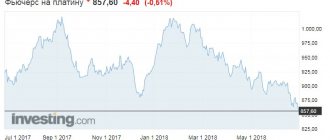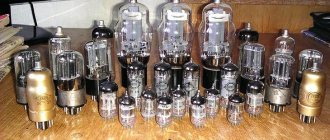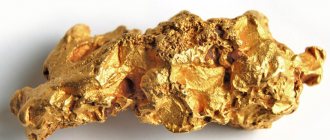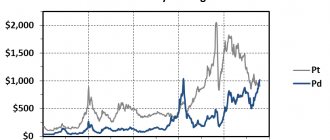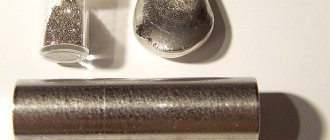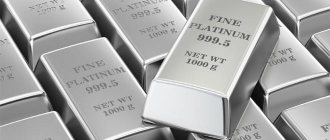Almost any radio-electronic equipment or device that was produced in the Soviet Union contained parts containing precious metals. Platinum and palladium have a small percentage in radio components. This need was dictated by the fact that it was necessary to ensure the longest service life of the device and its correct, accurate operation. Today, in many RECs, they have already found a replacement for gold and silver with cheaper elements of the periodic table, but platinum and palladium are still used in many areas of industrial production, which is due to their unique chemical properties.
Devices containing platinum
Platinum contains:
- automobile catalysts (see photo);
- capacitors;
- microcircuits;
- generators;
- relay;
- other details.
Since the auto industry and electronics are the main industries consuming platinum, when searching for primary secondary raw materials for extracting this metal, it is worth first of all paying attention to the devices produced by these industrial segments.
Let's look at the parts that contain the most .
Automotive catalysts
Among automobile catalysts, the following two types can be distinguished:
- Based on the classical platinum-rhodium-palladium system. The approximate metal content in parts per million per ton of ceramic support is respectively 1470-270-900 for the specified system. The approximate cost of such catalysts is 55 euros per 1 kg .
- Platinum-rhodium systems typical for premium car catalysts. Their platinum content is about 3000 parts per million . The cost of catalysts of this type is estimated at approximately 70 euros per 1 kg .
Knowing these formulas and the type of part, you can calculate how much platinum is in the car catalyst.
Capacitors
20% of the total mass of electronic devices are capacitors.
Depending on the type of capacitor, the amount of precious metals , in particular, platinum in capacitors varies , which determines the final cost of the product when it is purchased.
Below is a table of capacitors with markings and characteristic distinctive features in descending order of their platinum content and, accordingly, cost:
| External sign | Price (%) | Marking | |
| H30 | Thin, green | 100 | 5Н30_68Н_0481, 5_Н30_68Н_1079 |
| 5-D | Thin, green | 78 | 5D/68n/WD |
| H30 | Fat, red-haired | 68 | 4H30_47H_0578, 5H30_33H_0278 |
| 5D | Fat, red-haired | 65 | 4DB_68n_U3, 5D_47n_WD |
| H90 2M2 | Fat, red-haired | 52 | 6B_H90_2m2 |
| H90 1M0 | Fat, red-haired | 50 | 6H90_1M0_0582, 6_H90_1m0_0685 |
| KM, others | Thin, green | 45 | 5М75_1Н2_0572, 4М_Н47К_0375 |
| H90 | Fat, red-haired | 38 | 6_H90_m47_1085, 6BBF_m22_U7 |
Thus, the most valuable are H30 capacitors, which have the highest platinum content.
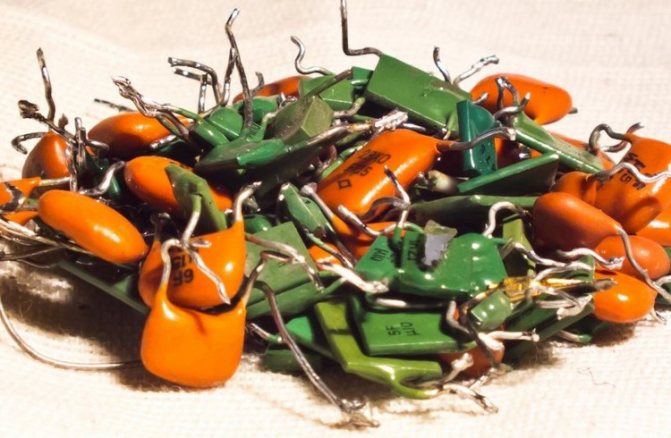
Other radio components
As for other radio components, platinum is present in:
- Relays , namely, wires and contacts in their composition. Among the most famous relays containing platinum are relays RES-9, RES-10.
- Electronic tubes .
- Microwave devices .
- Generators as part of control and measuring equipment (G2-57, GZ-109).
- Thermoelectric converters TPR .
We talked in detail about the content of various precious metals in radio components here.
Palladium and its uses
Palladium is a chemical element, a precious metal, also silvery white in color. Designated in the table as Pd. It was isolated from platinum ore by the English chemist Wollaston (1803). Palladium is widely used for the manufacture of capacitors, some types of relays, contacts, and in microcircuits. The metal was also used in Soviet times for the production of radio-electronic components, and it is still used today. It is most actively used in the electronic, chemical, military, and aerospace fields. Scientists are conducting experiments to expand the areas of use of this precious metal.
Microcircuits and capacitors contain a palladium-platinum alloy to improve the stability of the functioning of parts in any environment, including at a significant increase in temperature.
Applications of palladium
- Automotive industry. There is an urgent need in this industry to switch to palladium, since it has a lower cost than platinum, which is currently used in catalysts.
- Petrochemical industry. Used as catalysts (in chemical), oil cracking (oil and gas).
- Electrical engineering, radio electronics (for coating capacitors).
- Medicine.
Palladium is a commodity metal, its price on the London Metal Exchange is constantly growing, thanks to the expanding scope of palladium.
We will buy radio-electronic components containing platinum and palladium from you at very good prices.
Methods of extraction from radio components
To extract platinum, the most acceptable from an economic point of view is the collector smelting method , presented in a number of Russian patents RU 245899, RU 2180011.
The technology includes the following stages:
- Grinding of the original scrap.
- Melting scrap in furnaces in the presence of a collector metal.
- Blowing air through the melt to form collector metal oxide and molten platinum concentrate.
The difference in the methods lies in the stages of the processes and the composition of the collector system, which is responsible for the selectivity of the platinum separation process.
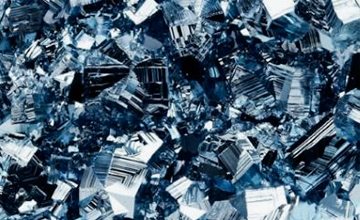
Isolation of platinum from electronic waste is also possible using the hydrometallurgical method .
One of the methods is to use the method of hypochlorite leaching of waste and is presented in patent RU 2244759.
The process is carried out at a certain concentration of hydrochloric acid and active chlorine (the source of chlorine is alkali metal hypochlorites) and a temperature of about 65 ° C, with a ratio of liquid to solid phase of 7:1.
When this method was used to recycle ceramic capacitors, the purity of the platinum was approximately 90% .
Another hydrometallurgical method is presented in patent RU 210339. Waste is treated with a mixture of hydrochloric acid, hydrogen peroxide and dimethylformamide (DMF) at a temperature of 100 °C.
As a result of the hydrolytic cleavage of DMF under the conditions used, platinum is reduced, after which DMF is regenerated, and the resulting solution is sent for processing.
In general, both hydrometallurgical and pyrolytic methods can be used to recycle electrical scrap to recover platinum. The same methods are recommended for metal extraction from spent catalysts.
The isolation methods presented above are the result of scientific research , fully or partially implemented in pilot and industrial production after obtaining the appropriate permits to carry out activities in the processing of precious metals.
On our website there is a separate material dedicated to platinum refining.
How justified is an investment in platinum?
At that time, it was possible to buy platinum at minimal prices. For some time at the beginning of summer, its cost even dropped below $800 per ounce. This level was last recorded more than nine years ago during the global economic crisis. The discount mark of platinum relative to gold then amounted to a record $440 per ounce. The same figure for palladium is $130 per ounce. As we can see, the dynamics of platinum do not fit into the general negative dynamics characteristic of other precious metals. This is explained by a number of fundamental reasons.
Most market players expected a repeat of the two-year shortage of platinum in the world, observed in the 90s of the last century:
- Johnson Matthey (JM) forecast seven-year high platinum surplus of 316,000 ounces;
- for the World Platinum Investment Council (WPIC) this figure is 180,000 ounces;
- Metals Focus, a consulting company specializing in precious metals, will not be able to sell 89,000 ounces of platinum.
An example of an exception to the rule is Thomson Reuters GFMS Corporation, which expects a platinum shortage of 380,000 ounces.
Demand for platinum has become much less than previously expected. At the end of winter it was expected to increase slightly due to increased investment. However, after a couple of months, the demand for the metal fell by almost 100,000 ounces. At the same time, global demand for platinum decreased by at least 200,000 ounces. The reason for this is the same auto industry, which is experiencing hard times due to environmental pressure on Western European manufacturers of diesel engines.
There is a decrease in consumption in the jewelry industry as well. Over a five-year period, demand for platinum jewelry decreased by 500,000 ounces. Today the situation here has improved a little. Which, however, cannot stop the decrease in demand from automobile manufacturers.
Some stabilization is observed due to the restored demand for gold jewelry in China. Here, manufacturers managed to take into account consumer requests. However, this can only be attributed indirectly to the demand for platinum, and the income from the low platinum price to gold ratio is expected to be small. Since, due to the long-term decline in the value of platinum, everyone thinks that this will continue, not many people want to buy jewelry made from it today. Experts predict an increase in demand for platinum for enterprises producing fuel cells, electrical equipment, petroleum products and petrochemicals.
Forecasts for increased investment in platinum are not so rosy due to the lack of incentives. Some experts expect the precious metal to stabilize at last year’s low levels, while others predict a further decline. Thus, the demand for platinum bullion in Japan will decrease even more. Due to the fact that it is highly sensitive to price dynamics, a decrease to minimum levels over a nine-year period, less than 3,000 yen per 1 gram, can push up the growth in demand. For example, a decrease in the price of platinum to 3,500 yen in the spring caused increased demand. Thus, you can expect a lot of surprises from investing in platinum.
Troubles in the platinum market can be expected from ETFs. From January to July, outflows from platinum ETFs amounted to about 100,000 ounces. Slightly positive dynamics in demand for platinum is expected. After last year's gain of 95,000 ounces, we have another twelve positive months ahead. Now, due to the decline in prices, few people are looking to buy platinum in the form of ETFs in large quantities.
Everyone agrees that the value of this precious metal has decreased significantly. Excess market supply, discount pricing characteristics relative to gold and palladium values, and an overabundance of short-term speculative trading are all reflected in the current price of platinum.
Low demand for platinum from the European auto industry will not last forever. Automobile manufacturers on other continents are already increasing its use in commercial vehicle engines in Asian and North American countries. After many years of decline, there should be a breakthrough in the jewelry industry. Declining prices have a negative impact on supply, slowing down its growth due to the unprofitability of mining the development of precious metal deposits.
If the demand generated by platinum investment continues to be stable, then the current year should bring with it a shortage of the metal. In the last months of the year, the price of platinum is quite capable of reaching $1,000 per ounce. And then it can already reach a four-digit figure. The expected further increase in the price of gold will also play a role here.
Sales of waste
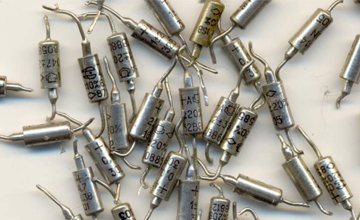
Among such organizations:
- ,
- ,
- NPO "Radiotechnical Precious Metals".
With the help of such companies, it is possible to carry out an expert assessment of the source material using physical and chemical analysis methods for an objective assessment of the cost of scrap and further professional processing of raw materials.
